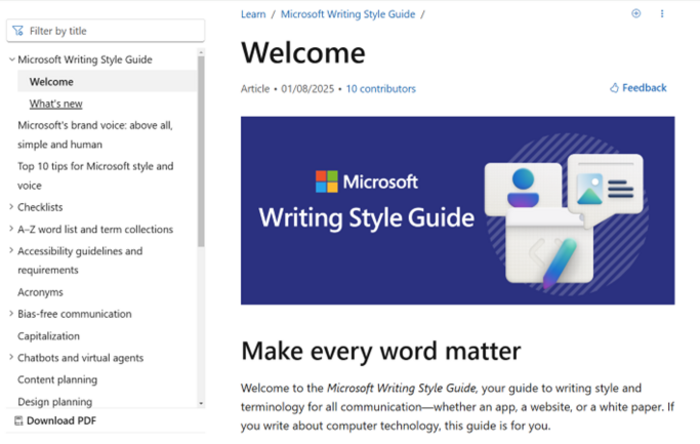A style guide plays a significant role in producing content in a consistent way. It provides a blueprint for standardizing writing style and tone. This helps your content writers to ensure uniformity across all your company’s communication channels. For customers, it makes your content easier to comprehend. A style guide helps to speak in the voice of your company’s brand and is an invaluable artifact for technical documentation teams.
What is in a style guide
The key components of a style guide include:
Terminology / Glossary – Defining business terms, abbreviations, and acronyms along with their definitions and conditions of use in business scenarios
Content structure – Defining rules for sentence structure, capitalization and punctuation, tone, voice, grammar, and narrative forms of speech
Content formatting – Guidelines for headings, lists, tables, images, and content layout; this also includes font, font size, code snippets, hyperlinks, and so on
Accessibility and inclusive language – Best practices for accessibility and inclusive language, aligned with the company’s brand guideline
During the onboarding of new technical writers, the company's style guide is introduced to ensure adherence to its writing standards. This session covers best practices for using the style guide and explains a framework for maintaining compliance with content policies, which includes regular audits, workflow, and accountability measures. This ensures that, even with multiple technical writers creating content, communication remains unified and consistent across all technical artifacts.
Challenges with style guide implementation
In many companies, style guides are lengthy and can require laborious training. Experienced technical writers may feel that they are well-familiar with the style guide and lose interest in it. But a style guide is a living document that gets updated with every new terminology or any other changes in the business. Thus, it is crucial for companies to organize regular meetings to ensure effective knowledge transfer to all content creators. However, this can be challenging due to the operational burden and the demands of business-as-usual activities.
There is no traditional system in place to check compliance with the style guide rules. Rather, it is enforced through people and business processes. This leads to non-conformance with the style guide in many scenarios. Sometimes, evolving changes in the style guide are overlooked in the review process. Since there are no benchmarks or scoring mechanisms to evaluate style guide adherence to new content, it is impossible to improve consistency across content. A lack of accountability is another barrier to improving writing in line with the company’s style guide.
The GenAI-infused style guide
The GenAI capabilities based on Large Language Model (LLM) can be utilized to enforce strict compliance with the company’s style guidelines. Any clause in the style guide can be referenced if a piece of text violates it. Let’s look at some common use cases.
Use case #1: Content creation using style guide
A GenAI toolkit can use a style guide to create new content. It is imperative for tech writers to record meetings with product teams or customer service specialists. These meetings can then be transcribed using voice-to-text conversion tools and can be fed into an LLM for further processing. The LLM can leverage the audio transcript and make use of the provided style guide to create content according to the company’s requirements. This could greatly enhance the technical writer’s productivity as a technical writer can produce effective technical documentation in response to frequent product feature releases.
Since style guides are tedious to adapt for writing, an LLM can ingest a style guide and create consistent technical content in no time. This means that a technical writer needs to be a reviewer rather than writing content from scratch. In this use case, it is particularly beneficial to leverage the power of LLMs to create content using your corporate knowledge sources.
Use case #2: Checking existing content for compliance
A GenAI tool can check content for compliance with style guide rules and can generate a report for the technical writer to review. Furthermore, it can recommend content correction based on guidelines detailed in the company’s style guide. This greatly augments a technical writer’s capabilities as they get immediate feedback (rather than waiting for the editorial) and reduces the iteration cycle.
Use case #3: Creating a style guide from existing content
Small companies might not have a style guide. Content was created organically and might have grown over time. In this case, all content and content templates can be fed into an LLM so that a style guide can be generated in accordance. It might not be the perfect style guide, but it will provide a draft that the technical writer can enhance by collaborating with other stakeholders in your company.
Creating style guides for LLM consumption
Creating a style guide for your company involves tremendous efforts and the support of many stakeholders to work out requirements. Alternatively, it is easy to adopt a recognized industry style guide and tweak it for your company’s requirements. For the software industry, recognized style guides include the Microsoft Style Guide and the Google Style Guide.
The most common style guide sections that require some tweaking include:
- Grammar: e.g., American English, British English, or Australian English
- Abbreviations, acronyms & initialism: e.g., API or A.P.I, plurals of acronyms, spell out abbreviations inside closed brackets followed by the acronym
- Use of apostrophes
- Use of symbols: ticks, crosses, etc.
- Capitalization: e.g., product name, company name, file extensions, sentence style capitalization
- Formatting: Italics for emphasis, ordered & unordered list, numbers in decimal/fraction format, URLs, website
- Terminology: list of allowed terms, list of not-allowed terms (synonyms)
- Voice and tone
- Paragraph styling: Long paragraphs to be avoided, work limit for each paragraph, avoiding nested ordered or unordered lists
- Adding hyperlinks: e.g., avoid generic lines such as “click here”, “read more”
- Code samples: add code comments
- Bias-free communication: using inclusive language such as layperson instead of laymen, and so on
Once your style guide is complete, you can feed it to your Large Language Model or GenAI chatbot using the context window. As new LLMs are launched, the size of context windows has increased, and they can now fit even large style guides. Using prompt engineering techniques, it is easy to create content using your style guide or check existing content against non-compliance.
Benefits
GenAI offers capabilities to create content from scratch using your company’s guide, check for compliance in existing content, and even produce a style guide if your company does not have one. These use cases provide extensive benefits to technical writers such as:
- Increased productivity as technical writers can produce more quality documentation with quick turnaround time. This leads to better customer satisfaction as customers can self-service using the latest technical documentation.
- Increased brand loyalty as customers are getting consistent messaging using well-known business terms in the right tone and voice
- A brand image that reflects bias-free communication that is inclusive and diverse
Conclusion
Inconsistent usage of business terms in documentation creates ambiguity and puts a strain on your customer support teams. GenAI toolkits can help to enforce strict writing standards across all writing artifacts and help technical writers produce content consistently. In addition, GenAI-based tools can produce content using the company’s style guide so that content is consistent from the first draft. It is high time that companies invest resources in enhancing style guides to help customers achieve their business goals.




